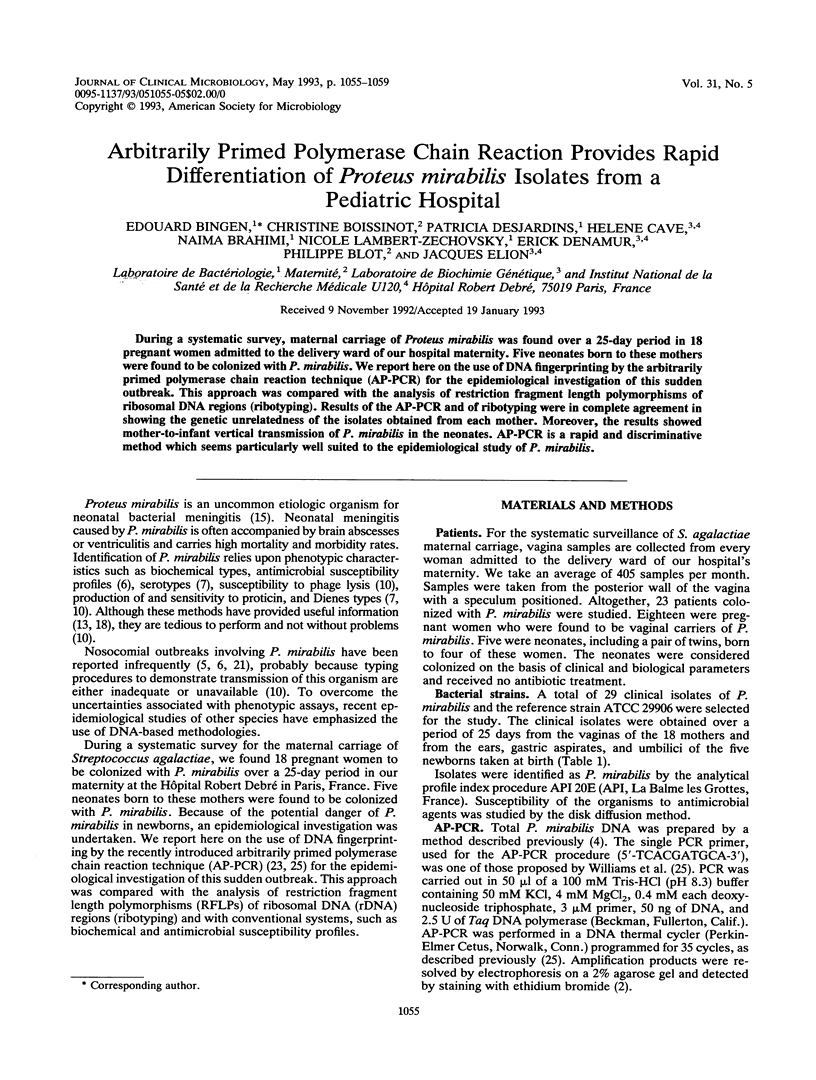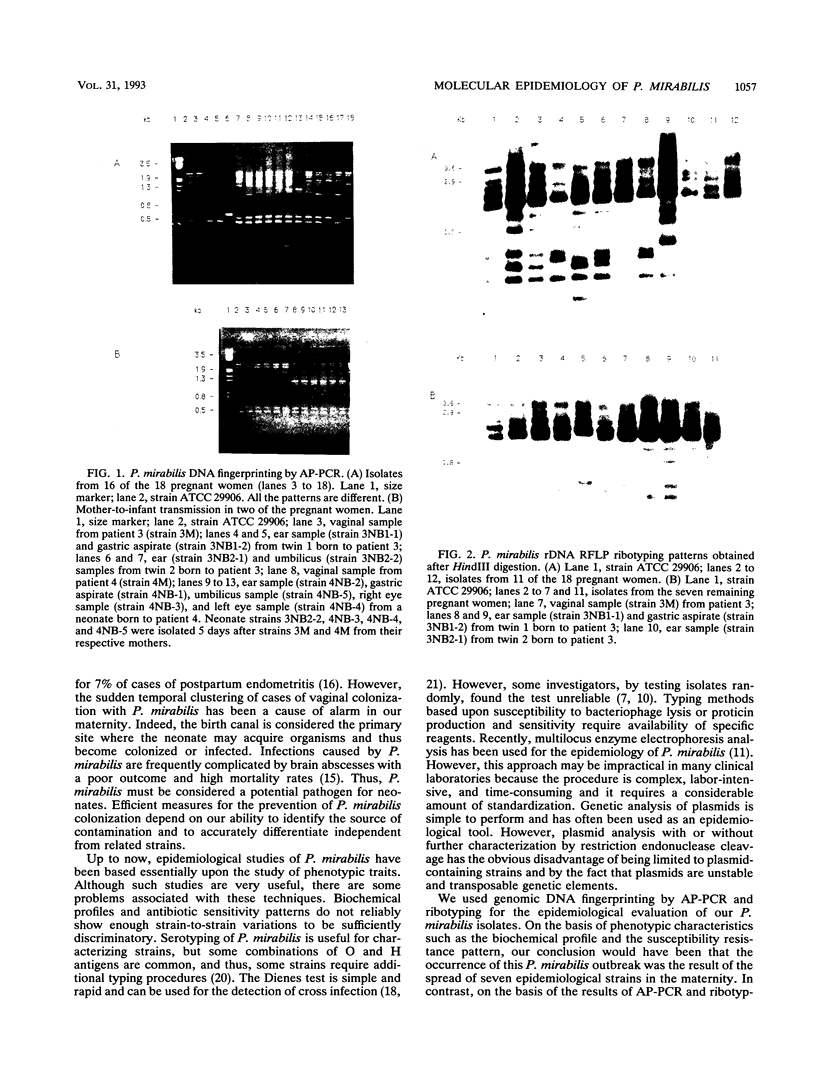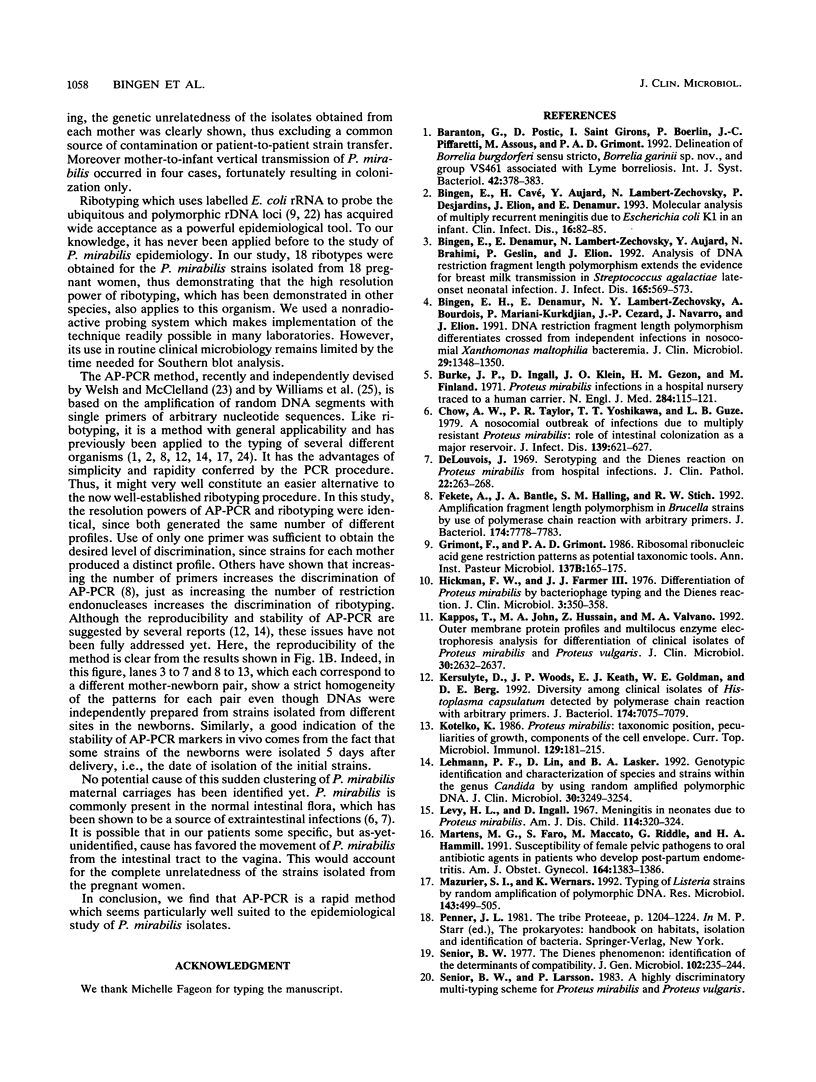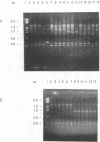Abstract
During a systematic survey, maternal carriage of Proteus mirabilis was found over a 25-day period in 18 pregnant women admitted to the delivery ward of our hospital maternity. Five neonates born to these mothers were found to be colonized with P. mirabilis. We report here on the use of DNA fingerprinting by the arbitrarily primed polymerase chain reaction technique (AP-PCR) for the epidemiological investigation of this sudden outbreak. This approach was compared with the analysis of restriction fragment length polymorphisms of ribosomal DNA regions (ribotyping). Results of the AP-PCR and of ribotyping were in complete agreement in showing the genetic unrelatedness of the isolates obtained from each mother. Moreover, the results showed mother-to-infant vertical transmission of P. mirabilis in the neonates. AP-PCR is a rapid and discriminative method which seems particularly well suited to the epidemiological study of P. mirabilis.
Full text
PDF




Images in this article
Selected References
These references are in PubMed. This may not be the complete list of references from this article.
- Baranton G., Postic D., Saint Girons I., Boerlin P., Piffaretti J. C., Assous M., Grimont P. A. Delineation of Borrelia burgdorferi sensu stricto, Borrelia garinii sp. nov., and group VS461 associated with Lyme borreliosis. Int J Syst Bacteriol. 1992 Jul;42(3):378–383. doi: 10.1099/00207713-42-3-378. [DOI] [PubMed] [Google Scholar]
- Bingen E. H., Denamur E., Lambert-Zechovsky N. Y., Bourdois A., Mariani-Kurkdjian P., Cezard J. P., Navarro J., Elion J. DNA restriction fragment length polymorphism differentiates crossed from independent infections in nosocomial Xanthomonas maltophilia bacteremia. J Clin Microbiol. 1991 Jul;29(7):1348–1350. doi: 10.1128/jcm.29.7.1348-1350.1991. [DOI] [PMC free article] [PubMed] [Google Scholar]
- Bingen E., Cavé H., Aujard Y., Lambert-Zechovsky N., Desjardins P., Elion J., Denamur E. Molecular analysis of multiply recurrent meningitis due to Escherichia coli K1 in an infant. Clin Infect Dis. 1993 Jan;16(1):82–85. doi: 10.1093/clinids/16.1.82. [DOI] [PubMed] [Google Scholar]
- Bingen E., Denamur E., Lambert-Zechovsky N., Aujard Y., Brahimi N., Geslin P., Elion J. Analysis of DNA restriction fragment length polymorphism extends the evidence for breast milk transmission in Streptococcus agalactiae late-onset neonatal infection. J Infect Dis. 1992 Mar;165(3):569–573. doi: 10.1093/infdis/165.3.569. [DOI] [PubMed] [Google Scholar]
- Burke J. P., Ingall D., Klein J. O., Gezon H. M., Finland M. Proteus mirabilis infections in a hospital nursery traced to a human carrier. N Engl J Med. 1971 Jan 21;284(3):115–121. doi: 10.1056/NEJM197101212840301. [DOI] [PubMed] [Google Scholar]
- Chow A. W., Taylor P. R., Yoshikawa T. T., Guze L. B. A nosocomial outbreak of infections due to multiply resistant Proteus mirabilis: role of intestinal colonization as a major reservoir. J Infect Dis. 1979 Jun;139(6):621–627. doi: 10.1093/infdis/139.6.621. [DOI] [PubMed] [Google Scholar]
- De Louvois J. Serotyping and the Dienes reaction on Proteus mirabilis from hospital infections. J Clin Pathol. 1969 May;22(3):263–268. doi: 10.1136/jcp.22.3.263. [DOI] [PMC free article] [PubMed] [Google Scholar]
- Fekete A., Bantle J. A., Halling S. M., Stich R. W. Amplification fragment length polymorphism in Brucella strains by use of polymerase chain reaction with arbitrary primers. J Bacteriol. 1992 Dec;174(23):7778–7783. doi: 10.1128/jb.174.23.7778-7783.1992. [DOI] [PMC free article] [PubMed] [Google Scholar]
- Grimont F., Grimont P. A. Ribosomal ribonucleic acid gene restriction patterns as potential taxonomic tools. Ann Inst Pasteur Microbiol. 1986 Sep-Oct;137B(2):165–175. doi: 10.1016/s0769-2609(86)80105-3. [DOI] [PubMed] [Google Scholar]
- Hickman F. W., Farmer J. J., 3rd Differentiation of Proteus mirabilis by bacteriophage typing and the Dienes reaction. J Clin Microbiol. 1976 Mar;3(3):350–358. doi: 10.1128/jcm.3.3.350-358.1976. [DOI] [PMC free article] [PubMed] [Google Scholar]
- Kappos T., John M. A., Hussain Z., Valvano M. A. Outer membrane protein profiles and multilocus enzyme electrophoresis analysis for differentiation of clinical isolates of Proteus mirabilis and Proteus vulgaris. J Clin Microbiol. 1992 Oct;30(10):2632–2637. doi: 10.1128/jcm.30.10.2632-2637.1992. [DOI] [PMC free article] [PubMed] [Google Scholar]
- Kersulyte D., Woods J. P., Keath E. J., Goldman W. E., Berg D. E. Diversity among clinical isolates of Histoplasma capsulatum detected by polymerase chain reaction with arbitrary primers. J Bacteriol. 1992 Nov;174(22):7075–7079. doi: 10.1128/jb.174.22.7075-7079.1992. [DOI] [PMC free article] [PubMed] [Google Scholar]
- Kotelko K. Proteus mirabilis: taxonomic position, peculiarities of growth, components of the cell envelope. Curr Top Microbiol Immunol. 1986;129:181–215. doi: 10.1007/978-3-642-71399-6_3. [DOI] [PubMed] [Google Scholar]
- Lehmann P. F., Lin D., Lasker B. A. Genotypic identification and characterization of species and strains within the genus Candida by using random amplified polymorphic DNA. J Clin Microbiol. 1992 Dec;30(12):3249–3254. doi: 10.1128/jcm.30.12.3249-3254.1992. [DOI] [PMC free article] [PubMed] [Google Scholar]
- Levy H. L., Ingall D. Meningitis in neonates due to Proteus mirabilis. Am J Dis Child. 1967 Sep;114(3):320–324. doi: 10.1001/archpedi.1967.02090240134015. [DOI] [PubMed] [Google Scholar]
- Martens M. G., Faro S., Maccato M., Riddle G., Hammill H. A. Susceptibility of female pelvic pathogens to oral antibiotic agents in patients who develop postpartum endometritis. Am J Obstet Gynecol. 1991 May;164(5 Pt 2):1383–1386. doi: 10.1016/0002-9378(91)91477-e. [DOI] [PubMed] [Google Scholar]
- Mazurier S. I., Wernars K. Typing of Listeria strains by random amplification of polymorphic DNA. Res Microbiol. 1992 Jun;143(5):499–505. doi: 10.1016/0923-2508(92)90096-7. [DOI] [PubMed] [Google Scholar]
- Senior B. W., Larsson P. A highly discriminatory multi-typing scheme for Proteus mirabilis and Proteus vulgaris. J Med Microbiol. 1983 May;16(2):193–202. doi: 10.1099/00222615-16-2-193. [DOI] [PubMed] [Google Scholar]
- Senior B. W. The Dienes phenomenon: identification of the determinants of compatibility. J Gen Microbiol. 1977 Oct;102(2):235–244. doi: 10.1099/00221287-102-2-235. [DOI] [PubMed] [Google Scholar]
- Skirrow M. B. The dienes (mutual inhibition) test in the investigation of proteus infections. J Med Microbiol. 1969 Nov 4;2(4):471–477. doi: 10.1099/00222615-2-4-471. [DOI] [PubMed] [Google Scholar]
- Stull T. L., LiPuma J. J., Edlind T. D. A broad-spectrum probe for molecular epidemiology of bacteria: ribosomal RNA. J Infect Dis. 1988 Feb;157(2):280–286. doi: 10.1093/infdis/157.2.280. [DOI] [PubMed] [Google Scholar]
- Welsh J., McClelland M. Fingerprinting genomes using PCR with arbitrary primers. Nucleic Acids Res. 1990 Dec 25;18(24):7213–7218. doi: 10.1093/nar/18.24.7213. [DOI] [PMC free article] [PubMed] [Google Scholar]
- Welsh J., Pretzman C., Postic D., Saint Girons I., Baranton G., McClelland M. Genomic fingerprinting by arbitrarily primed polymerase chain reaction resolves Borrelia burgdorferi into three distinct phyletic groups. Int J Syst Bacteriol. 1992 Jul;42(3):370–377. doi: 10.1099/00207713-42-3-370. [DOI] [PubMed] [Google Scholar]
- Williams J. G., Kubelik A. R., Livak K. J., Rafalski J. A., Tingey S. V. DNA polymorphisms amplified by arbitrary primers are useful as genetic markers. Nucleic Acids Res. 1990 Nov 25;18(22):6531–6535. doi: 10.1093/nar/18.22.6531. [DOI] [PMC free article] [PubMed] [Google Scholar]




